|
The Adirondacks, "Sanctuary of Dreams"
by Renee S. Gordon
|
"If future generations are to remember us with gratitude rather
than contempt, we must leave them more than the miracles of
technology. We must leave them a glimpse of the world as it was
in the beginning, not just after we got through with it."
Lyndon B. Johnson
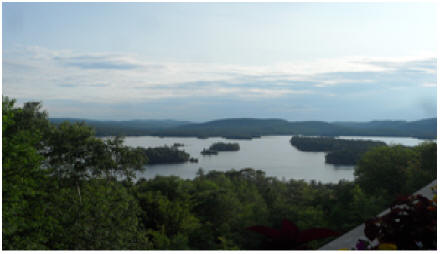
New York's Adirondacks State Park is a magnificent gem of
extremely underrated value. The 6-million acre park, larger than
Glacier Park, the
Grand Canyon,
Great Smoky Mountains,
Yellowstone, Yosemite
all put together, includes 8,000-sq. miles of mountains,
1,500-miles of rivers, 30,000-miles of streams, 2,000-miles of
foot trails and more than 2,300 lakes. It is also home to 66
fish species, and greater than 50 animal and 220 bird species.
It is an all season destination and visitors can engage in every
activity from Olympic level skiing to fall foliage viewing.
www.visitadirondacks.com
In 1885 the NY State Legislature designated the portion of the
land that the state owned, 2.3-million acre
Adirondack Forest Preserve, in 1892 the park was established and
in 1894 the Adirondacks were deemed a wild land preserve. It was
the first and sole wild land preserve to be protected by a state
constitution. In order to alter the law a change in the State's
Constitution is required. Article VII, Section 7 reads, in part,
"….shall be forever
kept as wild forest lands. They shall not be leased, sold, or
exchanged, or be taken by any corporation, public, or private,
nor should the timber thereon be sold, removed, or destroyed."
The Adirondacks is one of the oldest areas on earth, the oldest
on this continent and was created about 1-billion years ago.
Geologically they are part of the Canadian Shield and not the
Appalachian Mountains. When Native Americans entered the region
they did not settle in the mountains but passed through while
hunting, at war and trading. At the time of the first Europeans,
led by Samuel D. Champlain in 1609, the Algonquin and Iroquois
were the main tribes in the region and his party included
Algonquin guides. Ratirontaks became "Adirondacks," "those who
eat trees," and is actually an
uncomplimentary
Iroquois term they used to refer to their enemies the
Iroquois.
The New York frontier was settled early in the 1700s and played
a significant role in the French and Indian War, a territorial
conflict between the British and the French. The British
constructed Fort William Henry in 1755 on Lake George. It was
besieged in 1757 and after the British surrendered they were
killed by the Native American allies of the French as depicted
in "Last of the Mohicans." The French then destroyed it. There
are interpretive signs at the battle site and a replica of the
fort in Lake George village. www.visitlakegeorge.com
Fort Carillon, renamed Ticonderoga, was France's response to the
British. It was built 1755-59 on Lake Champlain. The fort saw
more fighting during the French and Indian War than any other.
It was also the location of the first American victory of the
Revolution when, on May 10, 1775, Vermont's Ethan Allen and the
Green Mountain Boys joined with Benedict Arnold to seize the
fort. The Battle of Fort Ticonderoga gave hope to the Americans
and provided supplies for their army. Ticonderoga offers great
tours and wonderful programming. Visitors should check in
advance for scheduled re-enactments, VIP Tours and special
exhibitions.
www.fortticonderoga.org
The preservation of the Adirondacks can largely be traced to one
man,
Verplanck Colvin, who began his career as a real estate lawyer.
Through his real estate business he discovered his love of
surveying. Born in Albany, he combined his love of exploration
with his admiration of the beauty of the Adirondacks, and began
visiting the less traveled areas of the region in the 1860s. In
1869 he ascended the 5343-ft Mt. Marcy, the highest point in the
state, followed by Mt. Seward the following year. He is credited
with locating the source of the 315-mile Hudson River. He gave
it the name Lake Tear in the Clouds. Indigenous tribes knew it
as "Muh-he-kun-ne-tuk", "the water that moves both ways".
In
1872 Colvin was appointed the
Superintendent of the
Adirondack Survey and subsequently State Surveyor. He
held this position for twenty-eight years and during that time
advanced the goals of surveying, conserving and preserving the
Adirondacks region.
Seneca Ray Stoddard published a tourist guide, "Adirondacks:
Illustrated," in 1873 and annually thereafter until 1914. It was
invaluable because it contained the first visitors' map and as a
result the latter part of the 19th-century, the
Gilded Age, saw a substantial increase in tourism. Stoddard was
an artist and his paintings, sketches and photographs document
the story of the region.
Many
of the wealthiest people, the Astors, Roosevelts, Vanderbilts,
Carnegies, etc., built Great Camps in the area as getaways from
the cities. They designed their retreats to blend into the
landscape using local stone and local wood and constructed by
local craftsmen with huge fireplaces and decks that took
advantage of the views. This form of architecture came to be
known as the Adirondacks-style. These "camps" were lavish and
luxurious and often far off the beaten path.
Blue
Mountain Lake's Adirondacks Museum presents an outstanding
overview of the region's history. The 32-acre campus houses 24
buildings and features activities, programs, events and special
exhibitions. The museum's collection showcases more than 30,000
objects and 70,000 photographs. A visit to this museum is a must
to fully understand the history, people, arts and industry of
the area. Plan to spend a minimum of 2.5-hours here just to
explore the museum buildings.
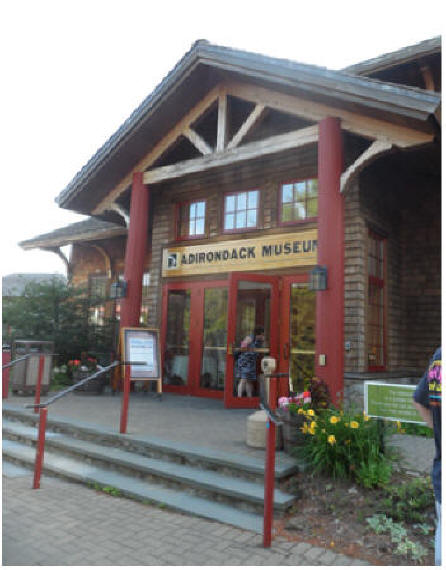
The museum site was originally Miles Merwin's 11,230-acre lumber
camp in the 1860s. One day a group of hunters appeared in camp
and offered to pay for the experience of lodging there. They
enjoyed themselves so much that they told friends and soon the
owner of the camp decided that he could make more money from
providing accommodations than from logging. In 1880 he built
Merwin's Blue Mountain House Hotel. In 1957 the property became
the Adirondacks Museum.
One of the first exhibits is a guideboat a unique and
significant form of regional transportation. Early tourists
could only travel so far by rail, stagecoach or foot and then,
because you are never more than .25-miles from water, it was
necessary to travel by boat. An industry sprang up of boat
building and guiding. Passengers would hire a guide to walk
along and carry a boat. When they reached water he would row
them across and then carry the boat to the next waterway.
Adirondack guideboats had to be lightweight and sturdy. During
the winter months the guides made twig furniture and the classic
Adirondack chairs. Bull Cottage, on the premises, is fully
decorated with rustic furniture.
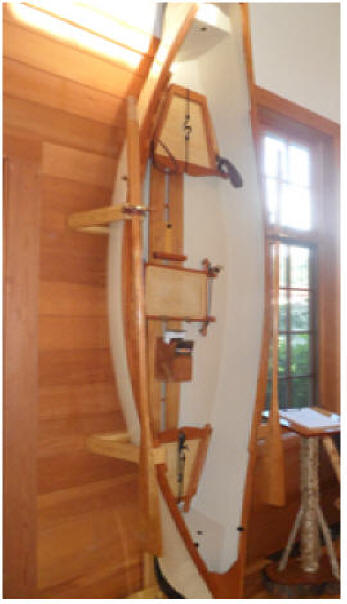
The
Roads and Rails exhibit is outstanding. Galleries are filled
with vehicles used to transport people to the camps. An ice
hearse is on display. This black lacquer sled conveyed bodies in
the winter. The lanterns held candles. A highlight is a private
rail car, the Oriental, of the type used by the wealthy to
travel to the Adirondacks. The car is nearly 70-ft long, has
6,900-ft. of mahogany, oil and electric lighting and one marble
and two onyx washstands.
One
of the more telling stories concerning the rich and the rails is
of the woman who disliked the stagecoach ride so intensely that
she asked her husband to do something about it. He built her an
opulent railcar to avoid the stagecoach, and a railroad track
2/3 of a mile long (about 6 blocks) for the railcar to ride on.
"Great Wilderness. Great Expectations: Masterworks from the
Adirondack Museum" currently displays 120 paintings, prints,
drawings and photographs that depict two centuries of regional
landscapes. This exhibition augments the museum's
Artist-in-Residence program.
www.adkmuseum.org
Garnet Hill Ski Lodge and Nordic Ski Center is both an
Adironacks destination and a wonderful place to enjoy the views
of Thirteenth Lake while dining on exqusite cuisine. Garnet Hill
offers first class accommodations and a full menu of year round
activities from which to choose. The owners provide exceptional
hospitality and service and they will make suggestions and
arrangements. Special programs sponsored by the lodge include
everything from a tranquil train ride to Yoga, using a stand up
paddle board. The lodge also offers 34-miles of cross country
ski and snowshoe trails, boating and free beginner ski clinics.
Here you can experience all the Adirondacks has to offer.
www.garnet-hill.com
The Summit at Gore Mountain is for travelors who seek a
different type of experience. The Summit's rental townhouses
include a dining area, fireplace, family accommodations with
bathrooms, kitchens, large living room with fireplace and
Jacuzzi. There is outdoor seating, panoramic mountain views and
they are the closest accommodations to Gore Mountain.
www.summitatgoremountain.com
New York's High Peaks Scenic Byway, Route 73, is one of the most
picturesque roads in the Northeast. This phenomenal drive is
only 30-miles but visitors get views of 46 mountain peaks
including both the highest and the lowest. You also pass
waterfalls, lakes,
rivers and awesome foliage. Driving straight through you can
complete the ride in under an hour but I suggest that you take
the day to picnic, hike, take photos and generally soak up the
beauty of one of America's wild land preserves.
High Peaks Byway is the only route into one of the Adirondacks
most recognized destinations, Lake Placid and next week we will
visit the closest place America has to Mt. Olympus. Information
on visiting the Adirondacks is available online. Remember the
region really dresses up for the fall. www.iloveny.com
"Old
John Brown's body lies a-mouldering in the grave, While weep the
sons of bondage whom he ventured all to save; But though he lost
his life in struggling for the slave, His truth is marching on."
Anon.

High Peaks Byway, Route 73, is the Adirondacks scenic route that
takes you into the Village of Lake Placid,
, the American Olympus,
one of only three cities in the world to have hosted the winter
Olympics twice. Just as Ancient Greeks made stops at sacred
sites to worship those traveling the route today can pause and
ponder the natural beauty of the picturesque ravines, valleys,
mountains and waterfalls that flank the road. The highway
bisects an extremely mountainous region of the Adirondacks and
showcases the highest peaks in the region. High Peaks Byway is
entirely within Essex County, one of the largest counties in the
state and Lake Placid is 1,967-ft. above sea level at its
highest elevation.
www.dot.ny.gov/scenic-byways
North Elba is a township four miles southeast of Lake Placid, a
village within that township. The area is referred to as Lake
Placid/North Elba. It was established in the early days of the
1800s as a result of the discovery of iron ore in the vicinity.
Lake Placid was part of the Adirondacks tourist boom in the late
19th-century and by 1900 Lake Placid was experiencing
its "Golden Age," with seven big hotels, numerous other
accommodations and activities and private great camps.
Melvil Dewey, inventor of the Dewey Decimal System, opened the
Placid Park Club in 1895 and convinced the town to change its
name to Lake Placid. In 1905 the club remained open at the end
of the summer thus helping the village to become known as a
winter destination and the first winter resort in the country.
Melvil's son Godfrey was instrumental in getting the
International Olympic Committee (IOC) to select Lake Placid to
host the 1932 Winter Olympics when he went alone to St. Moritz
to convince the committee in 1928.
www.lakeplacid.com
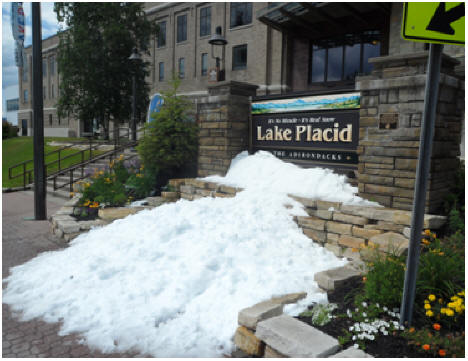
Seventeen sites are featured in Lake Placid's "Main Street
Walking Tour". The first structures were built in the 1870s
along Mirror Lake. The lake was once known as Bennet's Pond but
was renamed in 1870. Elijah and Rebecca Bennet were the first
documented white settlers in the area. Elijah was crippled at
Bunker Hill during the Revolutionary War and was given a pension
with which he purchased two 200-acre lots from the state.
Pioneer Monument, located on the lake, pays homage to the
Benjamin Brewster and Joseph Nash, early settlers of the area.
The land upon which Main Street stands once belonged to Nash.
The memorial is a small boulder with interpretive information
etched on it.
St. Eustace Episcopal Church was originally constructed on Lake
Street, and was known as St. Eustace-by-the-Lakes, in 1900.
Twenty-six years later the decision was made to move the church
to its current location on Main St. The church was dismantled,
the windows were removed and the timbers numbered. The church
was reassembled with a stone tower replacing the original wooden
one. This Gothic-Revival structure is situated atop a hill with
panoramic views of the lake and the town. Beautiful
stained-glass windows grace the interior with the most arresting
being the 3-paneled St. Eustace Window. Eustace is the saint of
hunters and it is believed he is memorialized in an unsigned
Tiffany creation.
www.steustace.org
Lake Placid Olympic Center was constructed in stages with the
earliest, Neo-Classical section, designed by William Distin as
the Olympic Arena in 1932. The Visitor Center is to the right of
the arena with the 1980 arena, to the left. A popular belief is
that Lake Placid is where
"miracles are made" and you can feel its special aura as you
near the Olympic complex. Visitors can experience the thrill of
winter sports year round through public skating, and national
and international competitions. Athletes continue to train here
and one should not be surprised to encounter Olympic level
competitors in casual settings.
The
1932 Winter Games were held February 4-15 and, because of
international economic conditions, were attended by only 17
countries but were exciting nonetheless. These games were only
the 3rd Winter Games of the modern era. American
Eddie Eagan earned the distinction of being the first person to
win a gold medal at both the Winter and Summer Olympics in
boxing and bobsledding. Two-man bobsled competition was
introduced at the games and was won by American brothers. They
heated the runners of their sled prior to the race, a practice
that has since been banned. In 1980 Winter Games were the
setting for "The Miracle on Ice," the US men's hockey team's
victory over the Soviet Union. Daily 15-minute tours are
offered.
The historic Golden Arrow Lakeside Resort has the best location
in Lake Placid, on Mirror Lake and Main Street. The
resort was the first in the nation to receive Audubon
International's Platinum Eco Rating for Hotels and has
vigorously instituted a sustainable green program that includes
everything from eco-friendly light bulbs to
a 3,400-sq. ft. green roof and a crushed limestone beach.
Resort guests can take advantage of the private beach, , night
club, Sauna and Fitness Center. There are a wide selection of
accommodations from deluxe rooms to family suites and pet
friendly rooms. Generations, the resort's restaurant, is open
three meals a day and uses locally produced food. A number of
specialty packages are offered with additions such as a Gondola
Cruise on the lake, Adirondack Scenic Flight and he Total
Olympic Experience. The Golden Arrow is celebrating its 40th
anniversary of ownership by the Holdereid Family. During that
time the resort has hosted many renowned guests including the
Austrian National Ski Team.
www.golden-arrow.com
A glass-enclosed elevator at the Olympic Jumping Complex whisks
you to the observation deck of the K-120 (393.7-ft.) meter jump
for outstanding views of the entire region. Visitors also tour
the ski jumpers preparation room.
www.whiteface.com
The
Olympic Bobsled Experience is one for your bucket list. Visitors
can join a professional driver aboard a bobsled and zip along
the famous 1980 bobsled track. Reservations are required and
must be made a minimum of 48-hours in advance.
www.whiteface.com/activities/bobsled-experience
Lake Placid Toboggan Slide has been one of the village's most
popular sites since it opened in the 1960s. Toboggans take turns
going down a 50-ft. high converted ski jump trestle and out, as
far as 1,000-ft. depending on the ice, onto Mirror Lake. The
chute operates from December to February depending on the
weather.
www.northelba.org/?page=government/park-district/toboggan-chute
Lake Placid Olympic Museum explores the history of the resort
and the Winter Olympic Games of 1932 and 1980. It presents a
brief but thorough overview that adds considerably to your
understanding of the region and its significance of winter
sports.
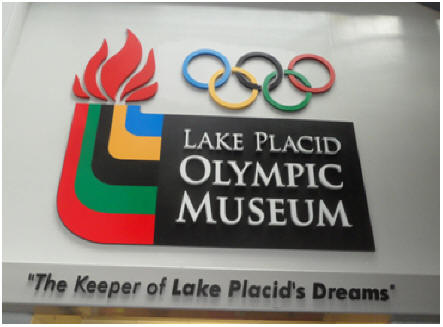
As you enter the museum the first exhibit provides the history
of the games. The
original Olympic Games were held in Ancient Greece every 4-years
in Olympia and can be documented to 776 BC. They continued until
outlawed in 393 by Emperor Theodosius for being pagan rites. The
games were dedicated to Zeus, their supreme god, and the final
award ceremony took place in the vestibule of Zeus' temple. All
free Greek males were eligible to participate and the first
recorded winner was
Koroibos,
an unassuming baker. Unmarried women could be spectators but
married women could not, probably because all entrants competed
in the nude. Any married woman caught attending the games was to
be thrown off a cliff to her death. The games were revived in
1896 and held in Athens with 13 nations in attendance.

Highlights of the displays are a gallery of Sonja Henie's
costumes and photographs. The "Norwegian Doll" was the first
winter athlete to capture the world's attention and go on to a
lucrative film career. The largest collection of Olympic torches
outside of Switzerland is also on view. Interestingly this was
originally a ritual and torchbearers carried the sacred flame to
the altar of Zeus, running a distance of 2,500-meters,
1.55-miles. The 1936 first torch of the modern games,
candle-lit, is displayed.
www.whiteface.com/facilities/olympic-center/olympic-museum
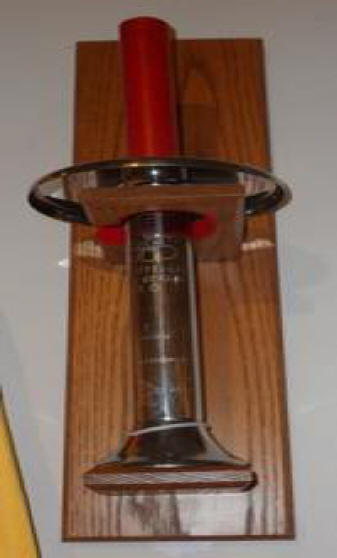
Gerrit Smith purchased a large amount of land in Upstate NY and
in 1846 he began selling farmland to African Americans in hopes
that they could gain self-sufficiency. Plots were sold to 2,000
blacks, approximately 140,000-acres, for $1.00 per plot. Four
hundred settled in the Lake Placid/ North Elba area in a
settlement known as the "Freed Slave Utopian Experiment," or
Timbucto on 17,000-acres. John Brown heard about the venture
and, being a farmer, came to North Elba in 1849 to volunteer his
skills. He purchased 244-acres of land and moved into a small
wooden cabin. The land was mountainous and the African Americans
largely lacked the skills to be farmers and by 1855 only ten
families remained on the land.
www.gerritsmith.org
Brown used the farm as a base but did not spend large amounts of
time there. His wife and family resided there as he fought in
Kansas and planned his infamous raid on Harpers Ferry.
www.northelba.org
On
October 16, 1859 Brown and followers attacked the US Arsenal.
The goal was to obtain weapons to arm slaves in the South so
they would have the means to rise up against their masters. On
October 17th word reached the citizens of Harpers
Ferry and Washington, DC. US Government troops under the command
of Robert E. Lee arrived and found Brown and his men pinned down
inside the armory.
On
the 18th a wounded Brown and six of his men were
captured and two of his sons and eight other men were killed.
The captives were taken to Charlestown, Virginia for
imprisonment and trial. Nine days later he went on trial for
murder, conspiracy and treason. On November 2nd the
jury deliberated 45-minutes before finding him guilty on all
counts and sentencing him to hanged in public on December 2nd.
He was pronounced dead at 11:50 AM on the 2nd.
The John Brown Farm State Historic Site is located a few miles
from Main Street in Lake Placid. The farm's tranquil setting
belies the significance of the man who lived there. The 4-room
farmhouse, built in 1955 by Brown's son-in-law Henry Thompson,
is the second on-site., replacing a log house. Furnishings date
from the era but only a bootjack is known to have belonged to
Brown. Guided tours of the house are regularly scheduled.
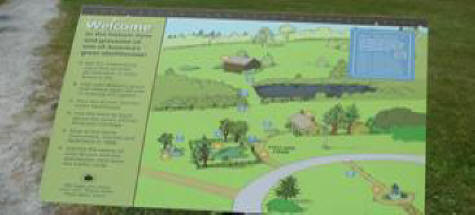 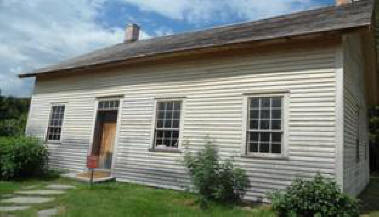
A
short distance away is the barn. It features interpretive
information on regional Adirondacks, African American history.
An excellent 15-minute video is shown on request, "Northward to
Freedom." The film relates first person narratives of fugitives
who arrived in the area. Most escaped along Blackman's Road, now
known as North Star Road. The most poignant tale is that of a
woman who gave birth to twins while fleeing. She ran away
several times, was caught, returned and severely punished.
Finally her owner beat her, slit her ears, branded her on her
stomach and hand and cut off her finger. This time the
punishment was so horrifying that the owner's wife helped her
escape. This film is intense but it is a must-see.
The family cemetery is located adjacent to the farmhouse. It
contains the graves of John Brown, his two sons and some of his
followers whose graves were relocated to this cemetery in 1899.
A large boulder and iron fence denote the location. After
Brown's execution his wife brought his body here for internment.
His son Watson's body was originally given to a medical college
in Winchester where it was used as an anatomical specimen until
the Union Army took possession of it. Interpretive plaques have
been placed around the farm and in the cemetery that interpret
the site, the events and the individuals.
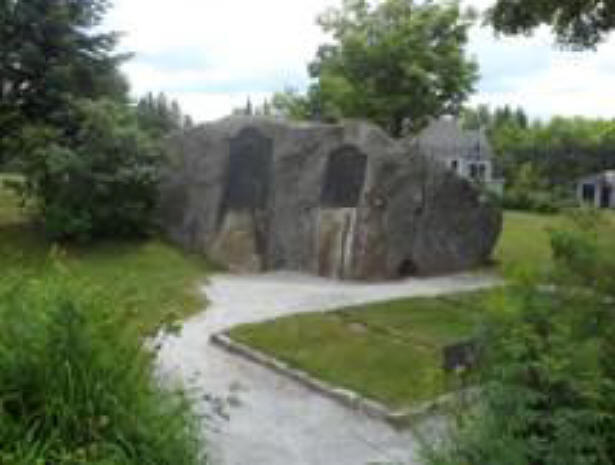
On May 9, 1935 a 6-ton commemorative sculpture by Joseph Pollia
was unveiled on the farm. The bronze sculpture is more than
8-ft. tall, on a granite base and depicts Brown and an African
American boy. The John Brown Memorial Association, an African
American group, provided the funding.
Lyman Epps Jr., a Lake Placid resident sang at the 1935 event.
Mr. Epps had been a soloist in 1859 at John Brown's funeral.

The 1824 Colonial Essex County Courthouse in Elizabethtown, NY
housed Brown's body on the evening of December 6, 1859. His wife
stayed in the Mansion House Hotel, directly across the street,
as a four-man honor guard, Henry Adams, Richard Hand, Orlando
Kellogg and A. C. Livingston stood watch over the body. The
funeral cortege set out again on the 7th and reached
North Elba in the early evening.
"John
Brown's Trial at Charlestown, Virginia" by David Lithgow hangs
in the courtroom. This massive, 6 x 9-ft. painting features a
courtroom scene from the trial including both the defense and
prosecuting attorneys. It debuted on December 11, 1923. Visitors
are allowed into the courtroom and it is much as it was in 1859.
www.co.essex.ny.us
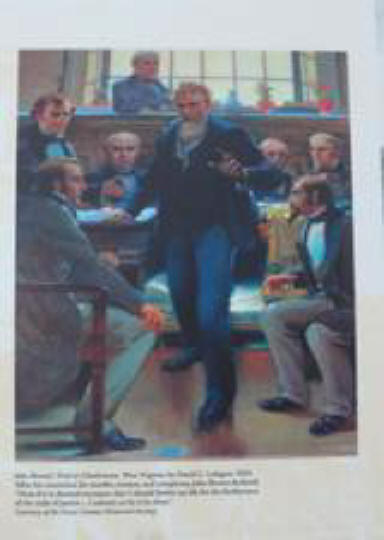
Lake Placid has it all and you can experience it year round.
Information on all the sites and attractions is available online
so you can craft a very special experience. Tour like an
Olympian.
www.iloveny.com
*This song was originally written about a Scotsman of the same
name. Julia Ward Howe used the tune for "The Battle Hymn of the
Republic".
|